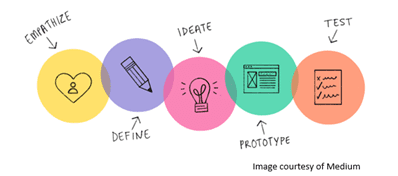This article originally appeared in the June 2021 American College Application Campaign newsletter.
 If you work in education long enough, you’ll eventually see or hear corporate jargon make its way into the collective vocabulary of the field. In some cases, these buzzwords fail to resonate with educators and fade like a bad fashion trend. But in other cases, they have staying power due to their positive effect on student success. And I believe when used appropriately, “design thinking” falls into the latter category.
If you work in education long enough, you’ll eventually see or hear corporate jargon make its way into the collective vocabulary of the field. In some cases, these buzzwords fail to resonate with educators and fade like a bad fashion trend. But in other cases, they have staying power due to their positive effect on student success. And I believe when used appropriately, “design thinking” falls into the latter category.
What is Design Thinking?
Over the last five years, design thinking – a human-centered innovation process used to deliver better products and services – has gained increased attention and adoption across a growing number of fields and disciplines. When done with fidelity, design thinking can produce improved outcomes in shorter amounts of time, leading to better products and services as well as more productive and enjoyable experiences for those tasked with delivering those services and experiences.
If there is any profession poised to incorporate design thinking principles to make a difference, it’s educators. Design thinking is founded on empathy, and educators are some of the most empathetic people on the planet! Let’s take a deeper look at design thinking and imagine how it might help us serve and support students who need it most.

How Can Design Thinking Help Students?
While there are different ways to define the design thinking process, it can generally be thought of as a series of iterative steps starting with empathy as the foundation, followed by ideating, prototyping, testing, and measuring. Let’s take a look at how this might translate to support student success.
Empathize. As noted above, design thinking is a human-centered approach to solving problems. And it begins by purposely and intentionally focusing deeply on others. This can mean observing, engaging, and/or immersing yourself in your students’ lives. Some call it ethnography; some call it qualitative data collection; others call it a needs assessment. It doesn’t matter what you call it. The point is that you find ways to walk a mile in your students’ shoes. Do you know which students might be most in need of help or support? Student-specific data (not aggregate) from your school might be an important tool for identifying those students and thinking deeply about their lived experiences.
After going through this step, you might, for example, discover that your students don’t think going to college is for them because they (falsely) believe they’ll have to successfully complete Calculus in college.
Define. Once you’ve done the work of deeply examining your students’ challenges and needs, it’s time to develop and articulate a clear statement of the problem you’re aiming to address. It’s possible – perhaps likely – that you identified several different types of needs or problems, but it’s important at this step to remain focused. Remember, we’re thinking about this through the lens of helping students who need it most. The “Problem of Practice” you define here will not only set the stage for your next steps, but it should also give you and your colleagues the inspiration you need as you work to support and encourage your students.
You might, for example, say, “The Problem of Practice is students who self-select out of college because they misunderstand college course requirements.”
Ideate. This is the space where magic happens. Have fun, be creative, think big, and be bold in your ideas, but remember to keep connected to the Problem of Practice you identified in the previous step. It can sometimes help to get the obvious ideas out of your head quickly so you can think beyond the strategies and approaches you may have used in the past. Don’t be afraid of asking questions like, “What might it look like to…?” as you explore possibilities.
As an example, you might say, “What if we design an interactive experience for students where we bring admission counselors to our school to help them learn about college majors and the courses required in each major.”
Prototype. This is when you begin putting ideas into the real world, whether that means a wall of post-it notes, developing a new or reimagined resource, writing a grant, or maybe building a new physical space. The point of prototyping is to force you out of the ideation stage and into a space where you can begin testing your idea. Your primary goal in the prototyping stage is to learn. Sometimes you’ll learn from failures. Other times you’ll build on successes.
Continuing with the example above, this might be where you begin contacting admission counselors from nearby colleges, reserving time and space at your school for the event, developing a communication plan, etc.
Test. Did it work? How do you know? Data is your most important tool at this stage. Consider collecting quantitative data (perhaps through short surveys) and qualitative data (anecdotes and feedback from candid conversations) from students, families, and/or other educators in your setting.
Keeping with our example, you might consider asking your students their beliefs about going to college before and then again after the college majors and coursework event to see whether you successfully addressed your Problem of Practice.
Supporting students in the 2020-21 academic year has been challenging to say the least. As you head into the summer with an eye toward the 2021-22 academic year, try using design thinking to find inspiration and gain back time as you consider ways to better serve your students.
